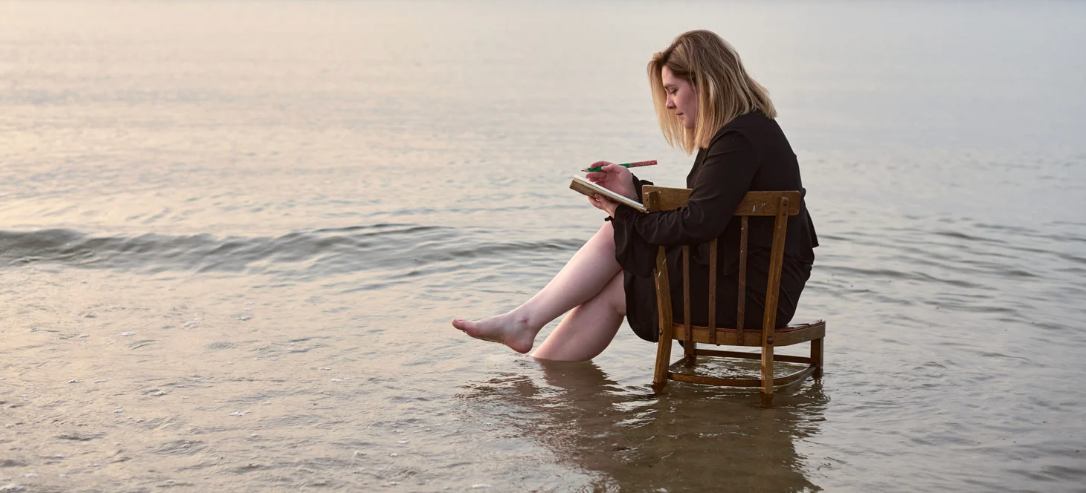18 comics that explain how to be creative when your family and self-doubt get in the way.
In need of some inspiration? These comics are for you.
I love being inspired.
Feeling inspired sends a pulse of golden energy through my body. And with it comes a buzz of flittering excitement.
All images used with permission from Sara Zimmerman at Unearthed Comics.
Like a wave, inspired creative energy brings with it a notion of hope, creativity, optimism, imagination, endless possibilities, and purpose.
Inspiration makes me feel invincible and aligned with my purpose for being on this planet. When I feel inspired, I feel like a superhero.
However, like one of those shady infomercials that promotes an uncomfortable sense of urgency, there is often a sense of timeliness that comes along with my inspiration, as if this creative effort needs to be done now or else I might lose it. Or worse: Someone else might get this idea and publicize it first.
If life went exactly as I wanted it to, I would drop everything and respond to this call of creativity right away.
But often, even when I schedule time to create, it goes less like my ideal situation and a little more like this:
Regardless, my creative drive is so strong that once the distractions are dealt with, I can usually manage to get in a few minutes of creativity.
Like a stubborn dog, inspiration doesn’t always come when I want it to, either.
Sometimes it comes at 3 a.m., rudely waking me from a comfortable slumber with a confused pomp and circumstance.
I toss and turn with thoughts as equally restless as I am, wondering what was so important to steal me from my dreams of gold and glory. After about an hour or so, I may get a hint of something glorious that needs to be manifested into this world.
Or sometimes it will come in the middle of the day, at work, when I really, really, really need to get other projects completed.
But at some point, when inspiration comes knocking at my door so loudly that the only option I have is to answer it, I make time to create — I have to. If not, I get edgy, resentful, and throw some artful adult temper tantrums.
After my pity parties and tantrums subside, I usually allocate some time to create, either after my daughter goes to bed, in the middle of the night when I can’t sleep, or even 15 minutes between projects during the day.
Then, just when all is quiet and in place and nothing else needs my attention and is absolutely perfect — just then when I think all will go my way — just then, my own thoughts can even backfire sometimes.
Instead of optimizing my precious time, I start feeling those waves of guilt that kept me from creating in the first place because I am not sure if I really should create or if I should be a responsible mom/wife/friend/business owner instead.
But, like I said before, if I don’t honor my creative spirit, I get cranky — super cranky.
So I do some self-talk to justify taking a little bit of time during the day for me. And yes, though I still feel some of the guilt when I start creating, it always feels so worth it when I am done.
If my internal judge shows up and decides to start criticizing, saying that what I am making is utter crap (which she does quite often), sometimes I completely embrace it by creating the absolute ugliest thing possible.
I choose the ugliest colors and just go, pushing paint, spreading paint, scraping paint, sometimes even smearing or removing paint. Or if I'm drawing, I work heavily in pencil with that handy kneaded eraser nearby, knowing that in the end, Photoshop can help me remove those little horrors if need be.
When I settle into it, just creating something can help me as a form of meditation.
And no, the initial product is usually nothing I want to show anyone. In fact, it can be terribly embarrassing when someone comes over to see something in this stage.
I used to get worried that people would think my art was crap. And though that is really frightening, I’ve found a lot of freedom in this process. So I push through the fear and embrace that the "ugly" stuff is just a representation of some of my more flavorful parts (like my anger, frustration, etc.), and these layers of "ugly" are just part of this whole process. All I can do now is just accept it.
Perhaps after I get through the layers of psychoanalysis and am able to remove my deep dark issues of unworthiness, abandonment, and repressed anger, my process will go more smoothly.
But for now, this is just one part of my creative process, and it's a part of me. So, as uncomfortable as it is, I usually choose to embrace it and just paint and create. And, despite the icky-ness and frustration, in the end, it feels amazingly freeing. And, though all of those processes seem sometimes so crazy and complex, once in awhile, when I just surrender to the will of the world, the trifecta of a beautiful meeting of time, inspiration, and effort will occur for me.
I don’t know when this trifecta will happen, and I can’t force it. Yet, when it occurs, I feel so blessed, like I have won the lottery.
It may be only five minutes, it may be five hours, but when the three come together: time, inspiration and energy, that is the circumstance where truly insightful creations can be manifested.
I have made it a priority for me to have creation time in my life because creating is a integral part of who I am. But the time I allocate for my inspiration doesn’t always procure masterpieces.
So I have to just take the inspiration when I can and realize that though I have a thousand ideas, some inspiration doesn’t need to be acted on.
I can choose to revel in the yumminess of the times when I can create, free of true judgment of the outcome of the piece and self-criticism, even if it is only three minutes of creation.
When I allow those hints of inspiration to come through, free of all the "shoulds," it is the best feeling in the world.




 Beaver on riverbank.
Beaver on riverbank.  Pbs Nature Swimming GIF by Nature on PBS
Pbs Nature Swimming GIF by Nature on PBS  An actual beaver dam on the now-thriving Price River
An actual beaver dam on the now-thriving Price River 
 11-year-old writes heartfelt letter to PE teacher disputing her grade and sparks heated debate
11-year-old writes heartfelt letter to PE teacher disputing her grade and sparks heated debate  An unfortunate volleyball hit.
An unfortunate volleyball hit.  You deserve a trophy!
You deserve a trophy! 
 Woman in denim jacket covers face with sleeve, standing outdoors with blurred background.
Woman in denim jacket covers face with sleeve, standing outdoors with blurred background. Woman with outstretched arms in a sunlit field, enjoying the outdoors.
Woman with outstretched arms in a sunlit field, enjoying the outdoors. Lush forest with vibrant green and orange foliage in soft, misty sunlight.
Lush forest with vibrant green and orange foliage in soft, misty sunlight. Friends laughing and drinking coffee at a cozy cafe table.
Friends laughing and drinking coffee at a cozy cafe table. Woman with curly hair in sunlight, eyes closed, wearing a purple top.
Woman with curly hair in sunlight, eyes closed, wearing a purple top. Man smiling with hand over face, standing outdoors against a blue sky background.
Man smiling with hand over face, standing outdoors against a blue sky background. Hand painting a still life on canvas with blue and orange tones.
Hand painting a still life on canvas with blue and orange tones. Woman sitting on a chair in the water, writing in a notebook at sunset.
Woman sitting on a chair in the water, writing in a notebook at sunset.

 An elderly couple walking in the park.via
An elderly couple walking in the park.via